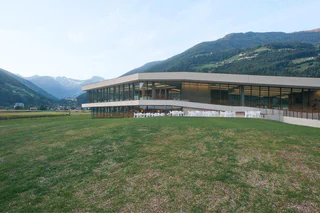
1/8
Cascade Pool
Campo Tures/Sand in Taufers, Sand in Taufers/Campo Tures, Ahrntal/Valle Aurina
L'architecture et l'innovation qui y est liée ont une grande importance dans le Sud-Tyrol. De plus, c'est une région qui ose beaucoup en matière de construction. En témoignent la distillerie de whisky unique en son genre, la salle d'escalade à la pointe de la technique ou encore le complexe hôtelier exceptionnel. Parfois sans prétention, parfois non, les ouvrages s'intègrent dans le paysage caractéristique du Sud-Tyrol - dans les montagnes ou entre les palmiers et les cyprès. Plusieurs fois récompensées et créées par des architectes locaux, chaque construction vaut le coup d'œil en soi. Découvrez l'interaction actuelle entre le paysage et l'architecture, qui n'existe qu'une seule fois sous cette forme.

1/8
Campo Tures/Sand in Taufers, Sand in Taufers/Campo Tures, Ahrntal/Valle Aurina

1/3
Glorenza/Glurns, Glurns/Glorenza, Vinschgau/Val Venosta

Tramin an der Weinstraße/Termeno sulla Strada del Vino, Alto Adige Wine Road

1/3
Merano/Meran, Meran/Merano, Meran/Merano and environs

Magrè s.S.d.V./Margreid a.d.W., Margreid an der Weinstraße/Magrè sulla Strada del Vino, Alto Adige Wine Road

1/8
San Martino i.P./St. Martin i.P., St.Martin in Passeier/San Martino in Passiria, Meran/Merano and environs

1/13
Sesto/Sexten, Sexten/Sesto, Dolomites Region 3 Zinnen

1/5
Marlengo/Marling, Marling/Marlengo, Meran/Merano and environs

Firmiano/Sigmundskron, Bolzano/Bozen, Alto Adige Wine Road

1/8
Brunico città/Bruneck Stadt, Bruneck/Brunico, Dolomites Region Kronplatz/Plan de Corones

1/4
Bolzano Centro/Bozen Zentrum, Bolzano/Bozen, Bolzano/Bozen and environs

1/8
Brunico città/Bruneck Stadt, Bruneck/Brunico, Dolomites Region Kronplatz/Plan de Corones

1/2
Pietrarossa/Rotwand, Ritten/Renon, Bolzano/Bozen and environs

Alpe di Siusi/Seiseralm, Kastelruth/Castelrotto, Dolomites Region Seiser Alm

1/6
Moso in Passiria/Moos in Passeier, Moos in Passeier/Moso in Passiria, Meran/Merano and environs

1/2
Malles/Mals, Mals/Malles, Vinschgau/Val Venosta

1/8
Selva/Sëlva/Wolkenstein/Sëlva, Sëlva/Selva di Val Gardena, Dolomites Region Val Gardena

S. Michele/St. Michael - Appiano/Eppan, Eppan an der Weinstaße/Appiano sulla Strada del Vino, Alto Adige Wine Road

1/8
Terlano/Terlan, Terlan/Terlano, Alto Adige Wine Road

1/2
Lasa/Laas, Laas/Lasa, Vinschgau/Val Venosta

1/19
Bressanone città/Brixen Stadt, Brixen/Bressanone, Brixen/Bressanone and environs

1/4
Scena/Schenna, Schenna/Scena, Meran/Merano and environs

Cornaiano/Girlan, Eppan an der Weinstaße/Appiano sulla Strada del Vino, Alto Adige Wine Road

Colma/Kollmann, Barbian/Barbiano, Brixen/Bressanone and environs

1/13
Obereggen/Obereggen, Deutschnofen/Nova Ponente, Dolomites Region Eggental

1/5
Naturno/Naturns, Naturns/Naturno, Meran/Merano and environs

1/5
S. Giovanni/St. Johann, Ahrntal/Valle Aurina, Ahrntal/Valle Aurina

1/5
Glorenza/Glurns, Glurns/Glorenza, Vinschgau/Val Venosta

1/8
Obereggen/Obereggen, Deutschnofen/Nova Ponente, Dolomites Region Eggental

1/2
Vipiteno/Sterzing, Sterzing/Vipiteno, Sterzing/Vipiteno and environs